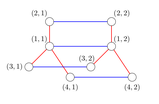Preparando MOJI
Consider a tree (that is, an undirected connected graph without loops) $$$T_1$$$ and a tree $$$T_2$$$. Let's define their cartesian product $$$T_1 \times T_2$$$ in a following way.
Let $$$V$$$ be the set of vertices in $$$T_1$$$ and $$$U$$$ be the set of vertices in $$$T_2$$$.
Then the set of vertices of graph $$$T_1 \times T_2$$$ is $$$V \times U$$$, that is, a set of ordered pairs of vertices, where the first vertex in pair is from $$$V$$$ and the second — from $$$U$$$.
Let's draw the following edges:
Please see the notes section for the pictures of products of trees in the sample tests.
Let's examine the graph $$$T_1 \times T_2$$$. How much cycles (not necessarily simple) of length $$$k$$$ it contains? Since this number can be very large, print it modulo $$$998244353$$$.
The sequence of vertices $$$w_1$$$, $$$w_2$$$, ..., $$$w_k$$$, where $$$w_i \in V \times U$$$ called cycle, if any neighboring vertices are adjacent and $$$w_1$$$ is adjacent to $$$w_k$$$. Cycles that differ only by the cyclic shift or direction of traversal are still considered different.
First line of input contains three integers — $$$n_1$$$, $$$n_2$$$ and $$$k$$$ ($$$2 \le n_1, n_2 \le 4000$$$, $$$2 \le k \le 75$$$) — number of vertices in the first tree, number of vertices in the second tree and the cycle length respectively.
Then follow $$$n_1 - 1$$$ lines describing the first tree. Each of this lines contains two integers — $$$v_i, u_i$$$ ($$$1 \le v_i, u_i \le n_1$$$), which define edges of the first tree.
Then follow $$$n_2 - 1$$$ lines, which describe the second tree in the same format.
It is guaranteed, that given graphs are trees.
Print one integer — number of cycles modulo $$$998244353$$$.
2 2 2
1 2
1 2
8
2 2 4
1 2
1 2
32
2 3 4
1 2
1 2
1 3
70
4 2 2
1 2
1 3
1 4
1 2
20
The following three pictures illustrate graph, which are products of the trees from sample tests.
In the first example, the list of cycles of length $$$2$$$ is as follows:


